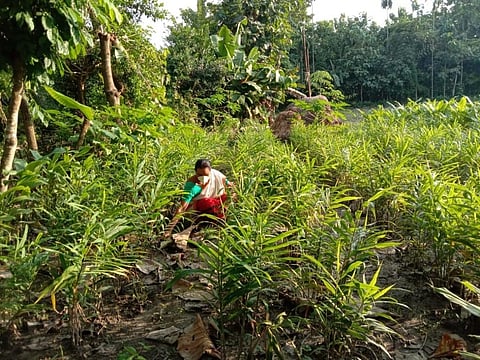

The Mishings, one of the earliest tribal communities of Assam, are a rare population group that escaped the stifling economic impacts of the novel coronavirus disease (COVID-19) pandemic. “We didn’t feel the economic pressures,” says Pabitra Mili, a member of the Mishing community from Baligaon Miri village in Sonitpur district.
What came to the community’s rescue is the revival of an ancient food-forest practice just a few months before the pandemic’s outbreak. Generally known as agroforestry, this is a form of farming where trees, shrubs, herbs and vegetables are grown together in a group mimicking a forest; the plants provide others benefits like shade, protection from predators, life-giving humidity and nutrients.
In 2019, Mili set about to revive this forestry practice in his village to augment residents’ income. Balipara Foundation, a nonprofit with expertise on income-generation programmes for tribal communities, helped him.
“The nonprofit helped us identify the crops ideal for our soil. I started promoting the concept among the 350 families in my village,” he told DTE. By November 2019, over 150 families were practising agroforestry.
Though the initiative was to ensure a steady flow of income for the families, it eventually became the reason the village survived the economic onslaught of the pandemic.
Earlier, the community, known for their exquisite weaving skills, grew a single crop in a season. But agroforestry is meant to diversify one’s food options, ensuring food security round the year.
“When the country was under complete lockdown, we harvested sweet potatoes, chillies, brinjal, turmeric and ginger,” says he. The lockdown disrupted supply chain across the country. But with diverse and locally harvested foods, the village didn’t feel the pinch.
By June 2020, some 200 migrant workers returned to the village as businesses shut down. “We took it as an opportunity to involve them in expanding our agroforestry,” Mili said. He initiated a plantation drive of commercially lucrative species like bamboo and amla on June 27 on village lands.
Since then, over 100,000 saplings have been planted. Around this, the master weavers Mishings have already a plan to manage the economic benefits. The village’s youth club has been assigned to collect forest produce, fruits and bamboo to sell and use the fund for local developments. Residents’ income has nearly doubled. Success breeds success.
On August 19, they set up a community seed nursery. “We are also trying to grow a local wild variety of mushroom. It is a part of our diet but finding it has always been difficult,” Mili said. That will be the future money-spinner.
The most definitive indicator of this experiment’s economic sustainability is that those who returned to village being jobless now don’t want to migrate again. “By 2021, we expect that all the 350 families in the village would be join agroforestry,” he added.
“Baligaon Miri experiment is a successful example of natural capital regeneration,” said Saurav Malhotra, the brain behind the Balipara Foundation’s Rural Futures programme. Natural capital indeed is the biggest income generator for rural Indians.
This was first published in Down To Earth’s print edition (dated 1-15 November, 2020)